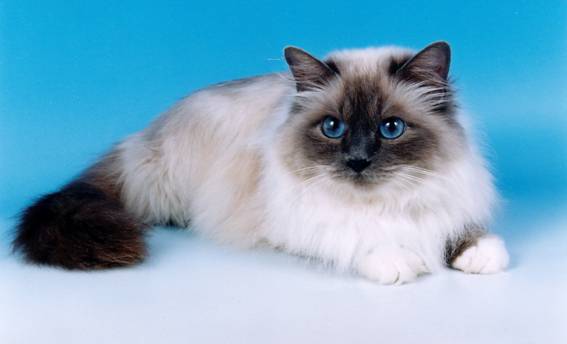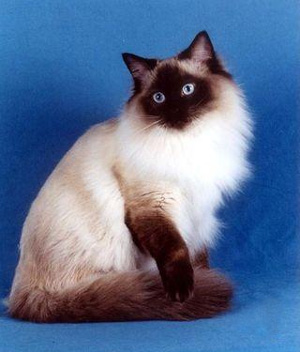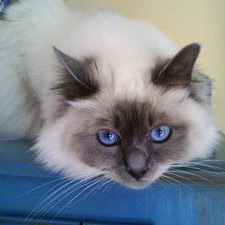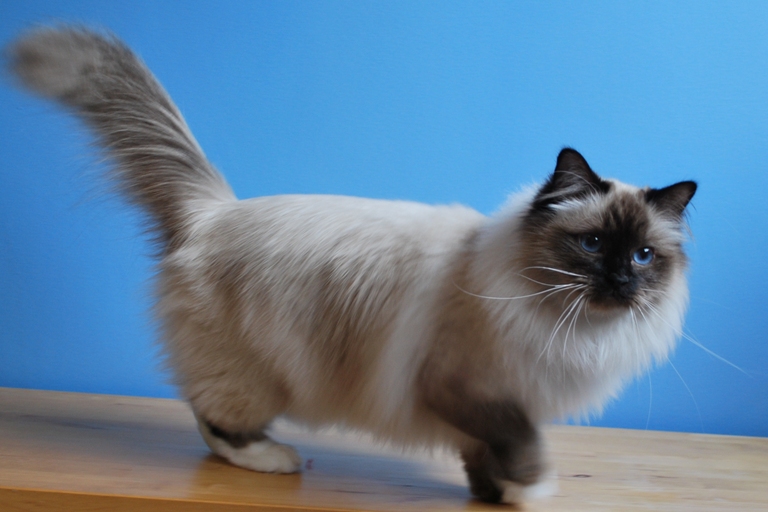
The Breed History
This Sacred Cat of Burma (Burma is now known as Myanmar) is a
distinctively coated and colored cat. Birman cats were prized by
priests and many legends surround their origin. A seal point queen
named Sita exported to France about the year 1919 gave birth to a
litter that became the foundation stock for the breed in the west.
By the end of the Second World War, they became almost extinct
in France and across Europe. Crosses with Persian and Siamese
cats followed. First specimens arrived in England in the 1960s and
the cats were first recognized in America by the CFA in 1967. No
outcrossing is allowed and in most other registries, the cat must
have five generations following an outcross in order to qualify. By
1999, with over 1000 cats registered, the breed entered the top 10
in CFA.
Traditionally, cats are named for the year of their birth by having
a standard letter of the alphabet to start their name. In 2003,
breeders started back at the letter "A" after cycling through the 26
years of the alphabet.
Physical Characteristics
Weight: 10-18 lb (4.5-8 kg)
Coat: Kittens are born white and the coat does not usually finish its
development until maturity, though pigmentation begins to develop
well before weaning. The medium-long single coat is full like the
Persian coat, but shorter and silkier in texture. Championship
CFA colors are the same as for Siamese breed cats. The gauntlet
markings (or laces) consist of white extensions of the mittens
running up the plantar surface of the metatarsals. This pattern
is an autosomal recessive trait. Ideally, the laces are one-half to
three-quarters of the height up to the tarsus.
Mittens do not extend above the point where the paw meets the
vertical limb on the forelimb. A mask covers most of the face. The
main coat is light in color and over the back and sides ideally looks
as if misted with a gold, termed golden mist; this overlay is often
absent in kittens.
Eyes: Large, wide set, sapphire blue. Deeper blue is better.
Points of Conformation: The face has a distinctive Siamese
look, but the heavier boning and round full face distinguishes
them. The face is more of a rounded-wedge. The profile is slightly
Roman-nosed, ears are small and wide set. Nose is medium in
length, forehead. The tail is full and moderate in size and length,
and the body of these cats is long. Limbs are heavily boned
and medium in length giving these cats a somewhat stocky
conformation. Paws are large and round.
Grooming: The Birman haircoat has low-moderate grooming
requirements and looks best with daily brushing; hair has a very low
matting tendency.
Recognized Behavior Issues and Traits
Reported breed characteristics include: Playful, friendly, calm,
though not as docile as the Persian, less active and less vocal than
the Siamese with a soft voice. A Birman may bond with one person,
and they may be somewhat territorial. Very affectionate, they are
somewhat of a lap cat. When upset, a Birman cat may make a huff
sound. Getting along well with cats, some will even offer to groom
their favorite. If the people of the house are absent during the day,
some sort of companion should be considered to help keep them
content.
Normal Breed Variations
Good longevity
Good mothering ability
Slow maturing
See Azotemia below in Congenital and Inherited Diseases-some
feel that this finding is a normal breed variation
Marked reduction in genetic diversity was identified in this breed
when compared to random bred cats in a study of 20 domestic and
2 wild cat breeds.
Birman Kitten Information Project: An Internet-based
breeder survey was carried out to establish normal baselines for
reproduction. Report: 59 reporting breeders, with 204 litters, 735
kittens. Sept 2003-Aug 2004
Average litter size 3.6
Stillbirth rate 7%
C-sections rate 9%
Average birth weight: Male 98 g female 93 g
Congenital defects:, seen in 8.3% of litters and included:
epibulbar dermoids, syndactyly (an autosomal dominant trait
with variable expressivity leading to a split paw), cleft palate,
umbilical hernia and open abdomen.
Type B Blood: The prevalence was reported to be 60% in a very
small study in Denmark. In an American report, 38 of 216 tested
were type B blood (17.5%).
Elsewhere, 18% and 16% type B cats were reported.
There are some rare type AB cats in this breed. In a group of 24 cats
surveyed in the UK, 8% were AB in this group while 29% were B,
63% type A.
Drug Sensitivities
None reported in the literature
Inherited Diseases
Azotemia: Birman cats were reported in a small British prospective
survey (n=106) of healthy cats to have a higher than expected
prevalence of azotemia, indicated by increased BUN and/or
creatinine. They found 82% of cats less than 6 months old had
creatinine levels above the feline laboratory reference range, and
in adults of average age 4 years, 35% had elevated levels. The
reason for the high frequency of azotemia in apparently healthy
cats was not discovered. Though renal disease was not tested for by
additional means, a serial blood test 18 months later for BUN/Cr did
not confirm significant progression of azotemia except in two cats
that succumbed to renal failure. It was suggested by the authors
that "one should consider renal dysfunction when undertaking
anesthesia, surgery or treatment" in this breed and test accordingly.
Inherited Defect of Neutrophil Granulation: The condition was
reported to be an autosomal recessive trait. A total of 46% of the cats
in the study population (n=78) were affected. The dark eosinophilic
cytoplasmic granules were functionally normal, but under the
microscope they had noticeably increased dye affinity, so if this
should be noted during diagnostic evaluation, it should be interpreted
that the neutrophils are still functional (incidental finding).
Neonatal Isoerythrolysis (NI): Prevalence of Type B blood type
leads to a higher potential incidence of neonatal isoerythrolysis
(NI) due to cold acting agglutinins. All B type cats have circulating
anti-A antibodies and even primiparous queens can carry these.
Type B queens bred to type A toms can result in fatal red cell
lysis in AA or AB blood type offspring with undetected NI. Kittens
with NI can be distinguished from other fading kittens because of
pigmenturia; anemia and icterus will also be present; not all kittens
at risk for NI will develop overt clinical symptoms. The proportion of
matings at risk for NI was reported to be 0.145. The proportion of
matings at risk for NI was reported as 0.13.
Breeders should be advised not to allow offspring resulting from
mating where blood types are unknown to nurse on the queen
for the first 18 hours. Breeders should be made aware of the
importance of testing since in that same recent survey, it was
reported that 52% of breeders had carried out at least one breeding
without typing the tom and queen. Foster nurse young kittens with
an A type queen or use milk replacer if blood types are unknown.
In one case report involving two litters, tail tip necrosis was
identified.10 High neonatal mortality or tail tip necrosis should
trigger tests for possible presence of NI.
Disease Predispositions
Arterial Thromboembolism (ATE): Birman cats were
overrepresented (odds ratio 10.52) in a population of 127 arterial
thromboembolism (ATE) cats in a study done at the University of
Minnesota Veterinary Medical Teaching Hospital from 1992-2001.
Most cats had left atrial enlargement.
Corneal Sequestration: Black body or cornea nigrum is often
bilateral and Birman cats are over-represented. Usually in central
cornea; it is a brown to black pigmented lesion; often surrounded
by a loose collarette of poorly adherent corneal epithelium. Defect
may extend into the middle or deep stroma-or even to Descemet's
membrane. Sloughing and corneal healing may take 2-6 months;
surgical debridement is another option. Epiphora, yellow-brown
ocular discharge and blepharospasm may be seen. This condition is
corneal stromal necrosis and topical glucocorticoids are contraindicated;
some cases may be linked to feline herpesvirus infection;
if suspected, do PCR on the black body tissue. Recurrences or
involvement of the second eye in previously unilateral cases may
occur.
FIP Susceptibility: Pedigree analysis indicated a heritability of
0.521 after correction for inbreeding in one cattery. It was proposed
to be a polygenic inheritance for susceptibility to development
of clinical FIP. Nine of 11 deaths occurred in cats related to one
tom-so it was correlated with relatedness. Macrophage viral
permissiveness may be the underlying functional defect.
An American study found that Birman cats were significantly
over-represented for a diagnosis of FIP when they analyzed data for
a 16 year period at a veterinary teaching hospital.
Respiratory Disease Propensity: There is anecdotal evidence of
more than expected prevalence in some catteries.
Rare and Isolated Reports
Cataracts: Congenital (present at birth), juvenile (newborn to
six years of age) forms have been reported with variable rate of
progression.16 Most cases have been noted in a Swedish family of
cats, where onset of lens opacity was noted in 2-5 year old cats.
Progressive worsening occurred and the problem was bilateral.
These were considered to be primary cataracts and type of opacity
varied. Two of the 6 observed cats had cataracts that normalized.
Peripheral and Central Distal Axonopathy: In a report, three
female littermates and a kitten from a previous litter with same
parents were similarly affected. Onset as early as 10 days, to 8-10
weeks of age, and signs included tendency to fall due to posterior
ataxia and weakness, and slowly progressive gait abnormalities such
as hypermetria and plantigrade stance. Histologic changes included
foamy axonal degeneration, myelinopathy, and both central and
peripheral nervous system distribution was noted. Sciatic nerves
were degraded, but spinal nerve roots were not. Two kittens were
reported elsewhere with primarily cerebellar lesions. A sex-linked
recessive gene with progressive penetrance was postulated.
Epibulbar Dermoid: Lateral limbus is reported to be the usual
location, and dermoids may be unilateral or bilateral. May or may
not be hair covered. May encompass bulbar conjunctiva, eyelid
margin and skin and may be associated with internal malformations
so ophthalmoscopic evaluation should be thorough (include
ophthalmoscope, biomicroscopy). First reported in Birman cats in
1985; mode of inheritance uncertain.
Eyelid Agenesis (frequently limited to upper and lateral eyelids):
these cats may have concurrent iris, lens and optic nerve colobomas.
This is the most common congenital eyelid defect in cats.
Congenital Hypotrichosis and Thymic Aplasia: A condition
where thymic aplasia of kittens and lack of haircoat occurred
simultaneously; reflects both ectodermal and entodermal defect.
In reported cases, death occurred by 13 weeks and some kittens
were born dead, some euthanized because of immune-compromised
state. By pedigree analysis it was considered to be an autosomal
recessive inheritance. The defect resulted in an overall reduced
number of hair follicles; those that were present were hypoplastic
with hairs generally in telogen, other lymph tissues such as Peyer's
patches, spleen and nodes were hypoplastic. This group consisted
of nine related kittens; all affected cats had a common great-great
grandsire.
Miscellaneous Reported Conditions:
Congenital portosystemic shunts: anecdotal, hepatic
encephalopathy, signs starting at 10-12 weeks of age.
Factor IX deficiency.
Pelger-Huet Anomaly: Neutrophil dysmaturity, likely autosomal
dominant. Heterozygotes clinically normal.
Genetic Tests
Blood typing before transfusions or breeding is recommended. If
kitten tail tip necrosis or neonatal mortality due to "fading kitten"
like syndrome occurs, test after the fact.
Renal function test: screening of BUN and creatinine pre-op
routinely for all cats is recommended.
Miscellaneous
- Breed name synonyms: Sacred Temple Cat of Burma, Temple Cat,
Mitted Cat
- Registries: TICA, CFA, ACFA, CFF, FIFe (Sacred Birman; SBI), NZCF,
CCA, WCF, GCCF, ACF
- Breed resources: National Birman Fanciers:
http://www.nationalbirmanfanciers.com/
Sacred Cat of Burma Fanciers: http://www.scbf.com/
North American Birman Fanciers (ACFA):
http://www.birman.org/newsletters/nabf.html
Photo Gallery of Breed - Birman - Cat Breed








 Animalia Life
Animalia Life